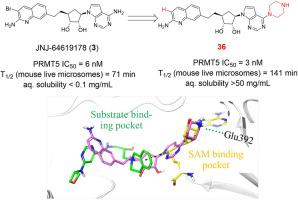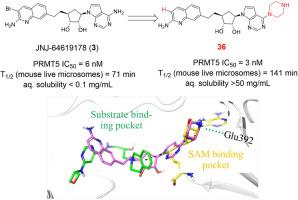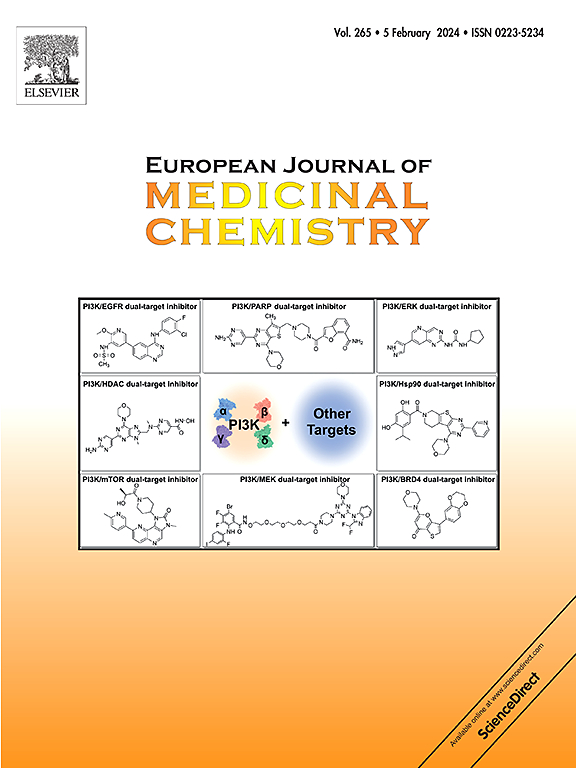One stone two birds: Introducing piperazine into a series of nucleoside derivatives as potent and selective PRMT5 inhibitors
IF 6
2区 医学
Q1 CHEMISTRY, MEDICINAL
引用次数: 0
Abstract
The protein arginine methyltransferase 5 (PRMT5) has emerged as potential target for the treatment of cancer. Many efforts have been made to develop potent and selective PRMT5 inhibitors targeting either S-adenosyl methionine (SAM) pocket or substrate binding pocket. Here, we rationally designed a series of nucleoside derivatives incorporated with piperazine as novel PRMT5 inhibitors occupying both pockets. The representative compound 36 exhibited highly potent PRMT5 inhibition activity as well as good selectivity over other methyltransferases. Further cellular experiments revealed that compound 36 potently reduced the level of symmetric dimethylarginines (sDMA) and inhibited the proliferation of MOLM-13 cell lines by inducing apoptosis and cell cycle arrest. Moreover, compound 36 had more favorable metabolic stability and aqueous solubility than JNJ64619178 (9). Meanwhile, it obviously suppressed the tumor growth in a MOLM-13 tumor xenograft model. These results clearly indicate that 36 is a highly potent and selective PRMT5 inhibitor worthy for further development.


一石二鸟:将哌嗪引入一系列核苷衍生物作为强效和选择性 PRMT5 抑制剂
蛋白精氨酸甲基转移酶 5(PRMT5)已成为治疗癌症的潜在靶点。人们一直在努力开发针对 S-腺苷蛋氨酸(SAM)口袋或底物结合口袋的强效、选择性 PRMT5 抑制剂。在这里,我们合理地设计了一系列与哌嗪结合的核苷衍生物,作为新型的 PRMT5 抑制剂,同时占据这两个口袋。具有代表性的化合物 36 表现出极强的 PRMT5 抑制活性,并且对其他甲基转移酶具有良好的选择性。进一步的细胞实验发现,化合物 36 能有效降低对称二甲基精氨酸(sDMA)的水平,并通过诱导细胞凋亡和细胞周期停滞来抑制 MOLM-13 细胞株的增殖。此外,化合物 36 比 JNJ64619178(9)具有更好的代谢稳定性和水溶性。同时,它在 MOLM-13 肿瘤异种移植模型中明显抑制了肿瘤的生长。这些结果清楚地表明,36 是一种高效且具有选择性的 PRMT5 抑制剂,值得进一步开发。
本文章由计算机程序翻译,如有差异,请以英文原文为准。
求助全文
约1分钟内获得全文
求助全文
来源期刊
CiteScore
11.70
自引率
9.00%
发文量
863
审稿时长
29 days
期刊介绍:
The European Journal of Medicinal Chemistry is a global journal that publishes studies on all aspects of medicinal chemistry. It provides a medium for publication of original papers and also welcomes critical review papers.
A typical paper would report on the organic synthesis, characterization and pharmacological evaluation of compounds. Other topics of interest are drug design, QSAR, molecular modeling, drug-receptor interactions, molecular aspects of drug metabolism, prodrug synthesis and drug targeting. The journal expects manuscripts to present the rational for a study, provide insight into the design of compounds or understanding of mechanism, or clarify the targets.

 求助内容:
求助内容: 应助结果提醒方式:
应助结果提醒方式:


